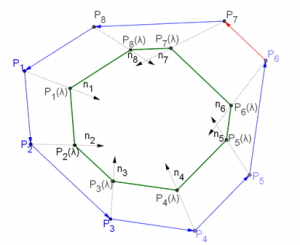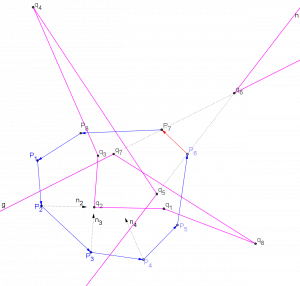Given a CEA polygon P1P2…PN, we define:
· The affine normal at Pi is the vector ni=Pi-1+Pi+1-2Pi (which is “twice the median” of Pi-1PiPi+1);
· The λ-parallel polygon has vertices Pi(λ)=Pi+λ.ni. Its sides are indeed parallel to the sides of the original CEA polygon. As λ varies, the λ-parallel polygons perform an affine evolution of the original CEA polygon.
· When the λ-triangle Pi-1PiPi+1 has a different orientation than the original Pi-1PiPi+1, we say that Pi(λ) is a cusp of the λ-parallel polygon.

Affine normals and the 0.6-parallel polygon. No cusps yet…
· The affine evolute is a polygonal curve with vertices qi= Pi(1/μi)=Pi+ni/μi. More precisely, if μiμi+1>0, the segment qiqi+1 is part of the evolute; but, if μiμi+1<0, the affine evolute includes the portion of the line qiqi+1outside the segment qiqi+1.

Affine evolute. Since μ6<0, “sides” q5q6 and q6q7 go through “improper points at infinity”.
In the Geogebra Applet below, you can construct your own CEA octagon (moving P1-P6) and play with the λ-parallel polygons (dragging λ – if your mouse hand is tired, just press the “play” button on the lower left corner and we will move λ around for you J). Whenever a vertex turns into a cusp, we mark it red.
Sorry, the GeoGebra Applet could not be started. Please make sure that Java 1.4.2 (or later) is installed and active in your browser (Click here to install Java now)
· In a CEAP, Pi(1/μi)= Pi+1(1/μi), so the vertices qi correspond to “shocks” of the Affine Evolution.
· In fact, the affine evolute turns out to be exactly the set of all cusps!
· The affine evolute reduces to a single point if, and only if, the original polygon is regular (modulo an affine transformation).
· When a curvature associated to an edge of the original polygon is negative, that edge becomes red. For example, in the original position, P6P7 is red because length(P5P8) > 3 .length(P6P7) and thus μ6<0. Note how P6(λ) determines two disconnected branches of the Affine Evolute (and so does P7(λ)).
[2] M. Craizer, R. Teixeira and M. Horta, “Affine properties of convex equal-area polygons”; Discrete & Computational Geometry, October 2012, Volume 48, Issue 3, pp 580-595.